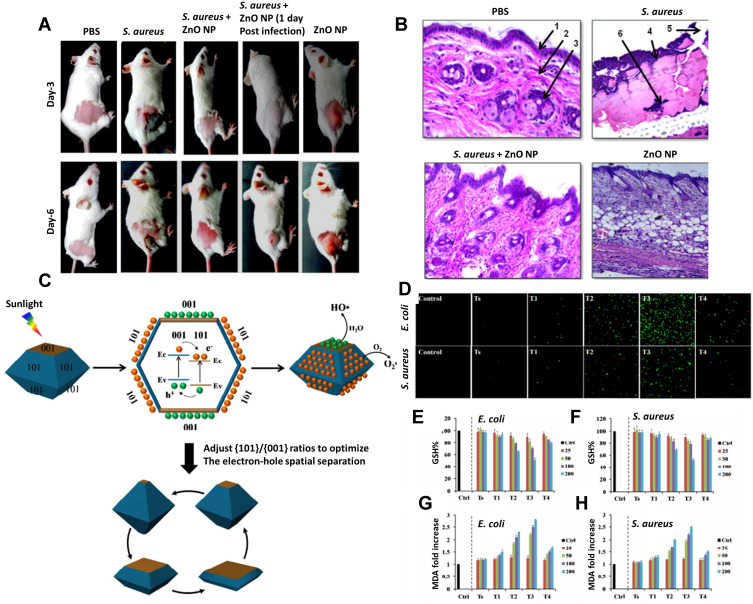Figure 9.
(A) Survival of S. aureus in ZnO-NP treated mice. Mice were infected intradermally with S. aureus and treated with ZnO-NPs simultaneously (S. aureus + ZnO NP) or 1 day after infection (S. aureus + 1d ZnO-NP). Mice injected with PBS and ZnO-NP alone were used as control. Seven days after infection, skin lesions were cut, homogenized and bacterial count was determined by CFU assay. (B) Histological appearance of mice skin biopsy; PBS treated, S. aureus infected, S. aureus infected and ZnONP treated and only ZnO-NP treated. On day 6, biopsy specimens were taken immediately after the termination of the experiment, fixed in 4% neutral buffered formalin and embedded in parafilm. The biopsy specimens were stained with hematoxylin and eosin. Numbered arrows indicate the following: 1, epidermis; 2, dermis; 3, sebaceous gland; 4, bacteria; 5, disrupted epidermal layer; 6, polymorphous infiltrate, consisting of mononuclear cells including lymphocytes and neutrophils. Experiments were performed in triplicates, results are shown mean ± SD; ***P ≤ 0.001. Adapted from Nanomedicine: Nanotechnology, Biology and Medicine, Vol 10/ Edition 6, Pati R, Mehta RK, Mohanty S, et al, Topical application of zinc oxide nanoparticles reduces bacterial skin infection in mice and exhibits antibacterial activity by inducing oxidative stress response and cell membrane disintegration in macrophages, Pages No.1195–1208, Copyright (2014), with permission from Elsevier.112 (C) {101}-{001} surface heterojunction-promoted electron-hole spatial separation. The conduction band and valence band edges of {001} facet are higher than those of {101} facets, facilitating electrons to transfer from {001} to {101} facets and holes from {101} to {001} facets under sunlight irradiation. The {101}/{001} ratio can be adjusted to optimize the electron-hole separation efficiency, maximizing the electron and hole accumulation on {101} and {001} facets, respectively. (D–H) Oxidative stress responses of E. coli and S. aureus bacteria treated or untreated with various TiO2 nanocrystals under simulated sunlight irradiation. (D) Fluorescence images of DCF-stained bacteria showing intracellular ROS production; Cellular GSH levels in E. coli (E) or S. aureus (F) determined by the GSH-Glo assay; Lipid peroxidation assessment of E. coli (G) or S. aureus (H) based on a MDA method. Bacterial suspensions (1×106 CFU/mL) were incubated with 200 µg/mL of TiO2 nanocrystals for 2 h under simulated sunlight irradiation, followed by 6 h incubation at 37 °C on a rotary platform at a 180 rpm. Adapted with permission from Liu N, Chang Y, Feng Y, et al. {101}–{001} Surface heterojunction-enhanced antibacterial activity of titanium dioxide nanocrystals under sunlight irradiation. ACS Appl Mater Interfaces. 2017;9(7):5907–5915. Copyright (2017) American Chemical Society.124

